| designs by Gary Lepak - Port
Angeles, Washington - USA |
Well, I have finally gotten around to making some
improvements on the Stoaproa
and getting some pictures taken on the water.
Safety Sponson
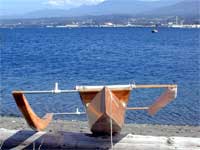
I have added a "safety sponson"
to prevent capsize from leaning too far
away from the ama. The ama weighs only
7 lbs and with an overall beam of only
4' there have been a couple accidental
capsizes by friends while paddling. The
possibility of capsizing has always made
me nervous too, and made me afraid to
sail it in all but the very lightest wind.
The new sponson solves the problem and
still allows enough space to paddle between
it and the hull. The sponson can slide
right up against the hull if I need to
enter or exit from a dock. The background
is Port Angeles Harbor from Ediz Hook,
the sand spit that forms the bay, with
some of the Olympic Mountains in the background. |
|
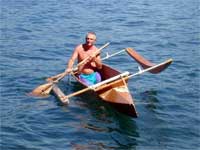
I spent some time at a local lake, Lake
Sutherland, this summer where it was warm
enough to not mind getting wet, unlike
the local 50° saltwater. This picture
shows the stability offered by the sponson,
which is 4" square and 8' long. The
top is 1/4" ply and the pink foam
is covered with one layer of 6 oz glass
and epoxy. |
|
Capsize Recovery

I capsized the boat by submerging the
ama and pulling the hull over. The ama
displaces about 60 lbs, small enough to
submerge but enough buoyancy to lift the
main hull mostly out of the water as it
rolls upright. This picture shows the
beginning of the righting sequence. The
Mirage drive hole makes a handy place
to grip the hull. |
|
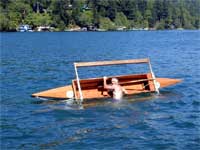
As the hull rolls upright, most of the
water bails itself out at about 90°.
I didn't get a picture of the moment the
boat flipped back upright, but in this
picture I have swum around to the other
side and submerged the ama again to get
more water out. With a bit more foam in
the ama, it would bail itself completely. |
|

Climbing back in is easy between the
ama and the main hull. There is no risk
of re-capsizing. |
|

This is all the water that was still
in the boat after righting. With my weight
at one end, this shows the deeper end
of the pool. Spread out evenly, it would
be about an inch or so. The water level
in the Mirage drive well shows the usual
draft, about 4".
|
|
Sailing
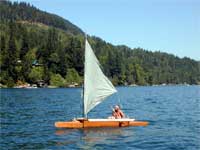
A couple years ago I tried sailing with
a small tarp lugsail. As I mentioned,
I never developed the sailing rig because
of fear of capsizing in cold water. This
summer after making the safety sponson,
I sewed up a little sprit sail from tarp
and had a good time sailing on the bay
and the lake. I have been sailing it as
a tacking outrigger rather than a shunting
proa, as it is not worth switching the
sail to the other end and with the banana
shaped paddling ama and sponson I try
to keep both of them out of the water
as much as possible on both tacks. I especially
enjoy sailing it with the ama to windward,
just kissing the surface or flying just
above it, but it is a balancing act to
keep it there with the main hull being
only about 16" wide at the waterline
and the windforce fluctuating quickly.
The sail looks better when there is some
wind in it.
|
|
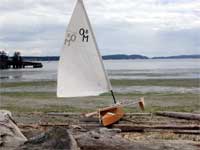
Last weekend I took the boat to Port
Townsend, 45 miles from here, and was
lucky to find a used sail in the local
marine salvage store for $60. It was an
almost perfect fit for my 14' windsurfer
mast and sprit boom, so with the tools
and a few screws I had with me I got it
to work and had a great time for few hours
sailing along the waterfront of this Victorian
maritime town, the home of the Port Townsend
Wooden Boat show. It is a Neil Pryde sail
about 45 sf from a Quartermaster 8 dinghy
made locally by Vashon Boat Works. |
|
 The
size is perfect for the Stoaproa, but it
will need some reef points for winds above
about 15 knots. I got into some afternoon
westerly gusty wind blowing me away from
shore and with the limited buoyancy of the
ama and sponson, my limited ability to steer
with the paddle and lean to windward at
the same time, I had to sheet out quite
a lot in the gusts. I had the Mirage drive
in place and had been using it off and on
all day, so simply pedalled straight back
to windward with the sail flapping in about
15 knots of wind to get closer to shore.
It also needs a larger leeboard for this
new sail. I was impressed that the Mirage
could make good progress against the wind
with the sail flapping. If I had to I could
have pulled out the mast, rolled the sail
around it, and tied it to the crossbeams
to reduce windage. It is a sleeve sail not
designed to have a halyard, but I will add
that capability. The
size is perfect for the Stoaproa, but it
will need some reef points for winds above
about 15 knots. I got into some afternoon
westerly gusty wind blowing me away from
shore and with the limited buoyancy of the
ama and sponson, my limited ability to steer
with the paddle and lean to windward at
the same time, I had to sheet out quite
a lot in the gusts. I had the Mirage drive
in place and had been using it off and on
all day, so simply pedalled straight back
to windward with the sail flapping in about
15 knots of wind to get closer to shore.
It also needs a larger leeboard for this
new sail. I was impressed that the Mirage
could make good progress against the wind
with the sail flapping. If I had to I could
have pulled out the mast, rolled the sail
around it, and tied it to the crossbeams
to reduce windage. It is a sleeve sail not
designed to have a halyard, but I will add
that capability. |
|
What Next?
Although it is a lot of fun to sail as it is, there
are improvements to be made, mainly to make it more
relaxing and handier. I've considered making it a
shunting proa with a larger ama, but the rig and steering
complications would take some time to work out, and
steering with a paddle can be inefficient and gets
tiring. Also, when pedal/sailing the Mirage drive
would have to be turned around in a shunt too. I also
thought of building a quick and dirty ply hull of
similar dimensions and sailing it as a catamaran,
which I probably will do some day to make it more
of a camp cruiser that could be beached or slept onboard.
I may do both of those eventually, but for starters
I have decided to make two new amas for it and sail
it as a trimaran. They will be 12' or so with a lot
more buoyancy and less rocker than the present paddling
ama. With the amas just above the water I will still
be able to sail just on the main hull when I want
to put in the effort to balance it, or I can sit back
and relax and let the ama do its work. I'm planning
on making the height of the amas above the water adjustable.
I'll make a larger leeboard and probably have a strap
above the waterline to hold it in place on both tacks.
I'll add a rudder with a yoke and long extensions
or lines so I can steer with my back to it with either
my hands or feet. I'd also like to set it up to row
with a sliding seat, as that is a form of exercise
I enjoy and I think will move it along faster than
the Mirage drive.
That should keep me busy for awhile. I'm hoping to
get the amas done soon so I can still enjoy them while
the weather is nice.
Gary Lepak
gnjlepak@olypen.com
Port Angeles, WA, USA
August 3, 2006

More articles by Gary Lepak:
|